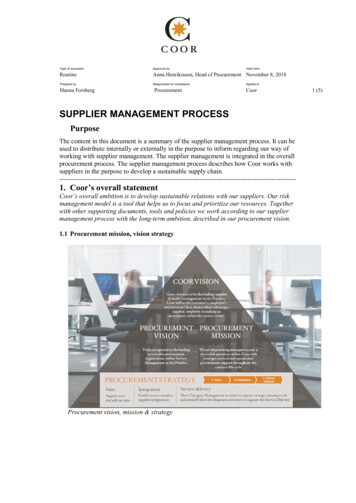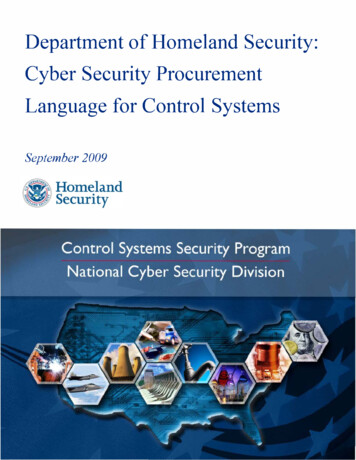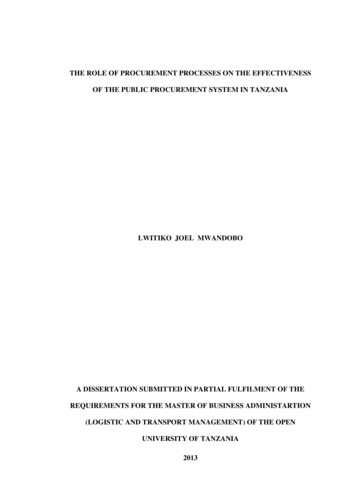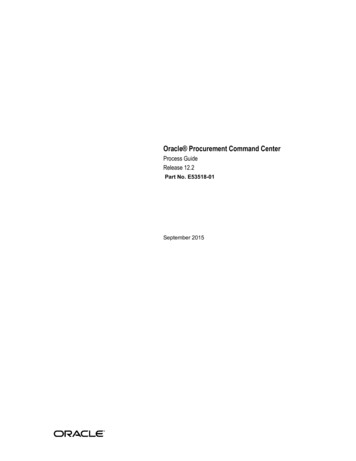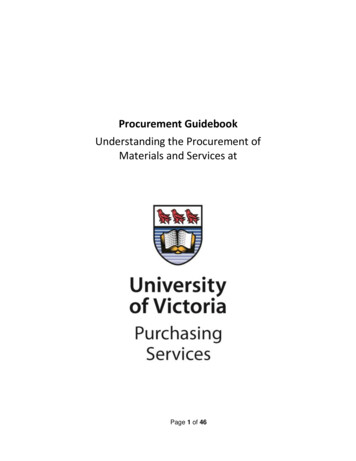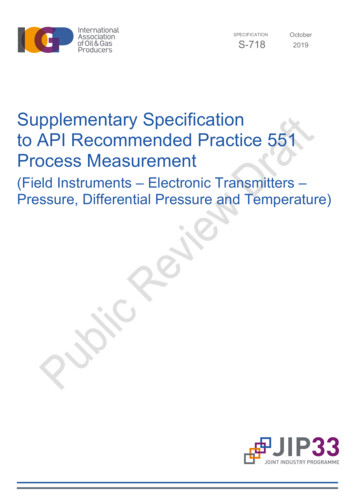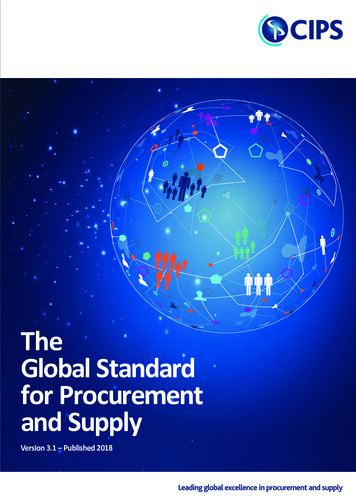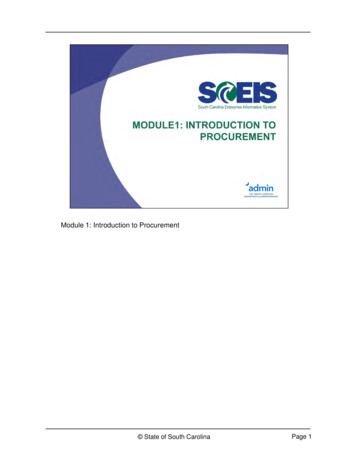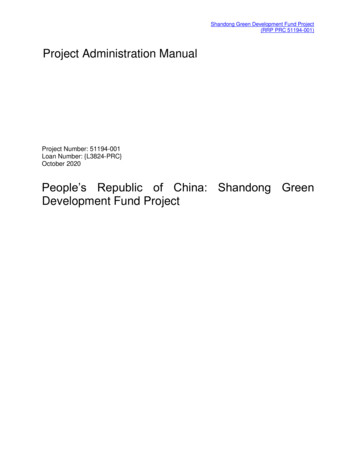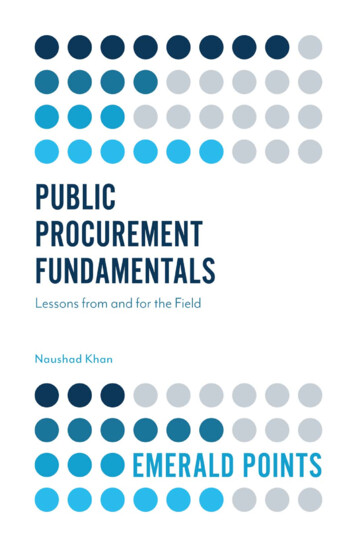
Transcription
PUBLIC PROCUREMENTFUNDAMENTALSLessons from and for the Field(INCLUDES A SIMPLESTEP-BY-STEP GENERICPROCUREMENT MANUAL)
This page intentionally left blank
PUBLIC PROCUREMENTFUNDAMENTALSLessons from and for the Field(INCLUDES A SIMPLESTEP-BY-STEP GENERICPROCUREMENT MANUAL)BYNAUSHAD KHANUnited Kingdom North America JapanIndia Malaysia China
Emerald Publishing LimitedHoward House, Wagon Lane, Bingley BD16 1WA, UKFirst edition 2018Copyright r 2018 Emerald Publishing LimitedReprints and permissions serviceContact: permissions@emeraldinsight.comNo part of this book may be reproduced, stored in a retrievalsystem, transmitted in any form or by any means electronic,mechanical, photocopying, recording or otherwise withouteither the prior written permission of the publisher or a licencepermitting restricted copying issued in the UK by The CopyrightLicensing Agency and in the USA by The Copyright ClearanceCenter. Any opinions expressed in the chapters are those of theauthors. Whilst Emerald makes every effort to ensure the qualityand accuracy of its content, Emerald makes no representationimplied or otherwise, as to the chapters’ suitability andapplication and disclaims any warranties, express or implied, totheir use.British Library Cataloguing in Publication DataA catalogue record for this book is available from the BritishLibraryISBN: 978-1-78754-608-0 (Print)ISBN: 978-1-78754-605-9 (Online)ISBN: 978-1-78754-607-3 (Epub)ISOQAR certifiedManagement System,awarded to Emeraldfor adherence toEnvironmentalstandardISO 14001:2004.Certificate Number 1985ISO 14001
CONTENTSAbout the AuthorixAcknowledgmentsxiForewordxiiiList of Abbreviationsxv1. What Is Public Procurement: Introduction135Pillars of Public ProcurementUniversal Principles of ProcurementProcurement and Public Finance Management(PFM)PFM CycleProcurement at National and Sub-national LevelsCentralized, Decentralized, or HybridPolitical Economy of ProcurementEconomic and Social Benefits of Public ProcurementInternational and Bilateral Support to PublicProcurementBasis of Public Procurement2. Who Does It and for Whom: Organizationand CapacityOrganizationBeneficiariesCapacityCapacity Issuesv891011161617192121252527
Contentsvi3. How It Is Done: Procurement Cycle andProceduresProcurement CycleProcurement Process for Goods and WorksPrequalification (PQ)Open TenderingRestricted or Limited TenderingRequest for Written Quotations (Shopping)Direct ContractingConsultant Selection ProceduresContract Negotiations and SignatureIndividual ConsultantsSingle Source SelectionTechnical ServicesBid Complaint Review Mechanism4. Contract Management5. How It Is Controlled: Risks to Procurementand Their MitigationRisksMitigationTransparency through Access to InformationPerformance Monitoring and Reporting6. New Tools of Public ProcurementChanging World and Growing EmergingMarket EconomiesNew ToolsFramework AgreementsCommunity-Based Procurement (CBP)Appendix A: Simple Step-By-Step GenericProcurement ManualSection 1: Preparation of a Procurement PlanSection 2: Universal Procurement 58690939797100
ContentsviiSection 3: Evaluation of Bids and ConsultantProposalsSection 4: Contract ManagementSection 5: Useful Procurement Links114118120Appendix B: Additional Readings121Index123
This page intentionally left blank
ABOUT THE AUTHORThe author served as a lead procurement specialist at theWorld Bank (WB) at its headquarters in Washington, DCbefore his retirement in late 2011. His last assignment at theWB was to support public procurement reform and capacitybuilding in the South Asia Region. He has a long experienceof public procurement reform and capacity building and theprocurement under the WB-financed development projectsin 35 countries in Eastern and Central Europe, Balkans,Caucuses, Central Asia, and South Asia. Of his 30 years atthe WB, he spent approximately 10 years of these in the clientcountries working directly with the client, i.e., staff of government implementing agencies. He was present in EasternEuropean countries (Czechoslovakia — later Czech andSlovak Republics; Hungary, Poland, Yugoslavia, etc.) duringtheir transition to market economy, and played a key role asa WB staff member in supporting these countries’ efforts inintroducing public procurement laws and regulations suitablefor the free market system. He conducted assessments of public procurement systems in many countries, includingAlbania, Armenia, Bhutan, Croatia, Hungary, Kazakhstan,Kyrgyzstan, Poland, Slovakia, Sri Lanka, Tajikistan, Turkey,and Ukraine. These assessments included recommended actionplans which led to further public procurement reform andcapacity building. The author managed several WB grantfunded projects in different countries in support of public procurement reform and capacity building. In order to fosterix
xAbout the Authorregional cooperation in public procurement, he initiatedregional public procurement forums in Central Asia and SouthAsia. In addition to making significant contributions to thepreparation of Standard Bidding Documents, such asfor procurement of works, he also designed procurementunder emergency projects in Bosnia, Kosovo, Poland, andTurkey. Currently, the author is an international procurementconsultant.
ACKNOWLEDGMENTSSincere thanks to the following knowledgeable and experienced colleagues for reviewing this book and for makingvaluable suggestions that significantly enriched its contents:Hiro Maruyama (Procurement — the Asian DevelopmentBank), Knut Leipold, Deepal Fernando, Nurbek Kurmanaliev,Fasliddin Rakhimov, Belita Manka, and Dilshod Karimova(PhD) (Procurement — the World Bank); Rama Krishnan,Nrpulat Daniyarov (Financial Management — the WorldBank); Sabri Koteci (Internal Auditor, Department forBusiness, Innovation and Skills, United Kingdom); AlmazbekDjanaliev (Procurement — OSCE, Vienna); and BakhtiyarKhamaraev (Procurement — UNDP, New York).Special thanks to Nadjib Sefta and Felipe Goya, my formerprocurement managers in the South Asia Region of theWorld Bank, for their guidance in improving the content andreadability of this book.xi
This page intentionally left blank
FOREWORDPublic procurement concerns and affects us all regardless ofwho we are, where we live, and what we do. Economic, social,and environmental benefits of public programs and projects to acountry and its citizens depend very much on how public procurement is managed, conducted, and controlled. These benefitsare supposed to be large as countries spend from 15 to 20percent of their gross domestic product on acquisition ofgoods, works, and services for public programs and projects.This indicates the importance of the alignment of public procurement strategies and actions to national economic, social,and environmental strategies and actions. Furthermore, publicprocurement can also serve as a useful tool for promoting international and regional cooperation through trade and commerce.Public procurement systems across countries are all basedin most part on the same basic principles of economy, efficiency, transparency, and fairness. These principles haveevolved and now include value for money, fit for purpose,and integrity. Therefore, the premise of this book is the commonalities of public procurement systems all over the world.Public procurement is a complex subject. It is multidisciplinary and cuts across all sectors of economy and society. Ithas a multitude of stakeholders with differing interests in andinfluence over procurement. Government itself is the rulemaker, the buyer, and the overseer; private sector, the producer and the manufacturer and provider of goods, works,and services; civil society, the watch dog to ensure that thexiii
xivForewordbenefits of a public project reach the people; and the people,the ultimate beneficiaries of government programs and projects supported by public procurement system.There exists a large amount of literature on public procurement that deals with different aspects of public procurement, including, among others, commercial, environmental(sustainable procurement), legal, and technical aspects. Thisbook, however, is introductory and attempts to bringtogether these different and complex aspects of public procurement in a clear and succinct, simplified, and understandable manner. These aspects relate to public procurementlegislative and regulatory environment; the institutionalframework and management capacity; procurement operations and market; and transparency.It is expected that this book will enable the reader to graspquickly and easily the fundamental principles and mechanicsof public procurement; and that this increased awareness willresult in improved performance of public procurement systems. In addition, it is hoped that this book and its accompanying generic procurement manual will be of particular helpto public procurement officials who more often than not haveto undertake procurement of goods, works, and services withlittle or no training in the subject. This book is also intendedfor use by private sector officials who are an integral part ofpublic procurement.A word of caution for the readers: this book includes universally accepted practices and procedures. Although publicprocurement legislative and/or regulatory framework in mostcountries are based more or less on the same procurementprinciples, there may be variations and departures from theseprinciples. Therefore, before applying the procedues andpracties contained in this book, it is imperative for the readerto ascertain that these are compatible with the national procurement laws and regulations.
LIST OF ABBREVIATIONSADBAsian Development BankCDDCommunity-driven DevelopmentCBPCommunity-based Procuremente-GPElectronic Government ProcurementEUEuropean CommissionFIDICInternational Federation of ConsultingEngineersGACGovernance and Anti-corruptionGPAGovernment Procurement AgreementITInformation TechnologyMDBMultilateral Development BanksM&EMonitoring and EvaluationMTD/SBDModel Tender Documents/Standard BiddingDocumentsMOFMinistry of FinanceOECDOrganization for Economic Cooperation andDevelopmentOSCEOrganization for Security and Cooperation inEuropePPAPublic Procurement AgencyPCProcurement Committeexv
List of AbbreviationsxviPEProcuring EntityPPProcurement PlanPPL/APublic Procurement Law/ActPPRPublic Procurement RegulationPPPPublic Private PartnershipPQRFPPre-qualificationRequest for ProposalTECTender (Bid) Evaluation CommitteeUNCITRAL United Nations Commission on InternationalTrade LawUNCACUnited Nations Convention against CorruptionWBWorld Bank
CHAPTER 1WHAT IS PUBLIC PROCUREMENT:INTRODUCTIONPublic procurement is an important government systemfor spending public money on acquisition of goods, works,and services needed for public programs and projects.Procurement comprises: (i) preparation of annual budgetwhen government agencies have to estimate their needs,(ii) procurement planning following budgetary allocation,and (iii) execution of procurement plans. Procurement plansare implemented using a procurement cycle that includes tendering or bidding, contract award, and contract management.The main objective of these activities is delivery of qualityand timely services to citizens through public programs andprojects, implementation of which is supported by publicprocurement.The procurement activity of the government begins withthe identification of inputs needed for implementing publicprograms and projects; categorization of these inputs intogoods, works, and services; estimation of their costs; selectionof suppliers; award of contract; contract management;1
2Public Procurement Fundamentalsdelivery and receipt of goods, works, and services; theirefficient and effective utilization; and proper maintenance.During the past two decades, public procurement hasevolved from being considered as just the simple purchasingof goods, works, and services to be handled by store clerksand purchasing officers to a complex government activity,inclusive of multiple stakeholders, to be conducted, managed,and supervised by qualified and competent public procurement professionals.The main objective of public programs and projects is toimprove the living standards of citizens. It helps convert limited resources into timely, cost-efficient, and effective services.Public procurement is critical for accountability of publicexpenditure and supports good governance, and it assistswith economic and social development and public trust ingovernment. Good procurement is essential for ensuringtimely delivery of goods, works, and services intended forcitizens; it also promotes competitiveness, trade (within andamong countries), and investment.The volume of procurement of goods, works, and servicesin every country is increasing rapidly, resulting from and inparallel with growth in economic activities. Access to information today has made citizens more aware of their rights ofaccess to benefits from public programs and projects; they arenow in a better position to challenge and scrutinize theoutcome of public procurements. They know that poor procurement practices can prevent them from receiving publicbenefits.Citizens now exert more and more pressure on theirgovernments for timely, quality, and cost-efficient delivery ofservices. This increasing pressure compels governments tofocus more sharply on improvements in procurement legislative and regulatory framework, procedures and practices, riskmanagement, enhancement of oversight and accountability,
What Is Public Procurement: Introduction3anti-corruption mechanisms, and the use of innovative tools/approaches, including e-procurement, public private partnership, third-party oversight, etc.The pace of the implementation of public procurementreform, however, is largely dependent on how a governmentorganizes itself and addresses the capacity-building needs ofgovernment agencies and public officials to manage, conduct,and control procurement. The goal of successful implementation of procurement reform is to have a significant impact onthe country’s economy and subsequent development of theprivate sector. However, in developing countries, very littleattention is paid to government organization and capacitybuilding and development of the private sector for andthrough public procurement.PILLARS OF PUBLIC PROCUREMENTLegislative/regulatory framework, including standard procurement documents: the public procurement regulatory framework comprises the implementation regulations and standardprocurement documents. The implementation regulations discuss in more detail the provisions in the public procurementlaw or act (PPL/A) so as to facilitate public officials’ adherence to them. Also, in order to facilitate the implementationtask of public officials, and with a view to standardizing theprocedures and practices of the conduct of procurement, thePPL/As also stipulate the preparation of standard prequalification/bidding documents as a minimum for goods, works,and services, as well as procurement manuals and standard/model specifications for the procurement of off-the-shelfgoods.Institutional and management capacity is required toensure that the public procurement system in a country is
4Public Procurement Fundamentalsfunctioning as part of the institutions and managementsystems that operate to ensure public sector governancein the country, including budget preparation, its executionand reporting; procurement regulatory body, its funding andstaffing; existence of institutional development capacity; andprocedures for collecting and monitoring national procurement data.Procurement operations and market practices: this pillarconsiders whether public procurement is effectively and efficiently functioning at the level of procuring entities. Giventhe importance of the private sector to procurement, it alsolooks at whether the private sector is strong and capable ofproviding competition; whether the private sector has anytrust in public officials conducting and managing procurement; whether it has easy access to credit to be able to participate in tendering, etc. It also ensures that the necessaryprocedures are in place that do not only keep the privatesector informed about the legal and procedural requirements of public procurement but also create an environment of trust by all parties in the public procurementsystem.Integrity and transparency of the public procurementsystem: this pillar ensures that the public procurement systemfunctions with integrity, that suitable controls supporting thesystem exist, and that appropriate anti-corruption measuresare in place to avoid any improprieties in public procurement. Therefore, this pillar considers effective control andaudit systems, efficiency of appeals mechanism, accessto procurement information, and ethics and anti-corruptionmeasures.Figure 1.1 shows the four pillars of public procurementdiscussed above.
What Is Public Procurement: Introduction5Figure 1.1. Pillars of Public Procurement.PUBLIC PROCUREMENTPILLAR I —LEGISLATIVEPILLAR II —PILLAR III —INSTITUTIONALPILLAR IV—ARRANGEMENT PROCUREMENTINTEGRITY ANDOPERATIONSANDTRANSPARENCYMANAGEMENT AND MARKETCAPACITYUNIVERSAL PRINCIPLES OF PROCUREMENTThe public procurement system in most countries is basedon the following seven globally accepted principles: valuefor money, economy, integrity, fit for purpose, efficiency,transparency, and fairness. The World Bank Policy on“Procurement in IPF (Investment Project Financing) andOther Operational Procurement Matters” issued on June 28,2016 (www.worldbank.org/procure), defines these principlesas shown in the following:1. “ Value for money means effective, efficient, and economicuse of resources, which requires an evaluation of relevantcosts and benefits, along with an assessment of risks, andnon-price attributes and/or life cycle costs, as appropriate.Price alone may not necessarily represent value for money.2. Economy takes into consideration factors such as sustainability, quality, and non-price attributes and/or lifecycle cost as appropriate that support value for money.
6Public Procurement FundamentalsIt permits integrating into the Procurement Processeconomic, environmental, and social considerations 3. Integrity refers to the use of funds, resources, assets,and authority according to the intended purposes and ina manner that is well informed, aligned with the publicinterest and aligned with broader principles ofgovernance all parties involved in the ProcurementProcess observe the highest standard of ethics andrefrain from fraud and corruption.4. Fit for Purpose applies both to the intended outcomesand the procurement arrangements in determining themost appropriate approach to meet the project development objectives and outcomes, taking into account thecontext and the risk, value, and complexity of theprocurement.5. Efficiency requires that procurement processes be proportional to the value and risks of the underlying projectactivities. Procurement arrangements are generally timesensitive and strive to avoid delays.6. Transparency requires (i) that relevant procurementinformation be made publicly available to all interestedparties, consistently and in a timely manner, through readily accessible and widely available sources at reasonableor no cost; (ii) appropriate reporting of procurementactivities; and (iii) the use of confidentiality provisionsin contracts only where justified.7. Fairness refers to (i) equal opportunity and treatmentfor bidders and consultants; (ii) equitable distribution ofrights and obligations between ; and (iii) crediblemechanisms for addressing procurement-related complaints and providing recourse .”
What Is Public Procurement: Introduction7If the above-mentioned principles of procurement are adheredto, contracts would be awarded impartially and on the basisof the merit of the bids. This would help achieve the objectiveof a program or project.While all the above-mentioned principles must always besafeguarded and followed, it is sometimes difficult to achieveeconomy and efficiency in procurement at the same time. Forexample, if items of goods, works, or services are neededimmediately — e.g., in emergency situations, man-made ornatural disasters — the government has to pay a higher pricefor obtaining the required item urgently. That means economy has to be compromised for efficiency and vice versa.Procurement is generally divided in three categories:goods, works, and services. All manufactured items, includingequipment, furniture, etc., are defined as goods while worksrelate to construction, repair, and rehabilitation of infrastructures, including buildings, roads, highways, etc. Services arefurther divided in two subcategories: (i) advisory and intellectual (consultant) services and (ii) technical services that arelabor and/or equipment intensive, such as cleaning, surveying, and mapping.GoodsManufactured goods, equipment, furniture, computers, material, and supplies are defined as goods.WorksConstruction, reconstruction, and rehabilitation of infrastructure, including all kinds of buildings, ports, highways, roads,and bridges are known as works.
8Public Procurement FundamentalsConsultant servicesIntellectual and advisory services are called consultancy services. Examples include project management, advice on privatization, design and delivery of training, etc.Technical servicesNon-intellectual services are technical services in which theelement of manual or machine inputs is substantial. Someexamples are: building maintenance, surveys, mapping, datacollection and inputting, etc.PROCUREMENT AND PUBLIC FINANCEMANAGEMENT (PFM)The need that countries have for program and projects toimprove their citizens’ living standards is always higher thanfunds they have available at any time. This means that governments are always faced with the difficult task of prioritizing their programs and projects on the basis of competingstrategic, policy, urgency, and other criteria. The PFM has animportant role to play in this process.PFM relates to collection of resources and their efficientand effective allocation for government programs (also calledbudget formulation); it includes efficient utilization of thesescarce resources, including economic and efficient conduct ofprocurement, and a system of controls to ensure that budgetentities use budget funds with care. Public procurement is akey element of the resource management process within anyPFM system (see Figure 1.2). Procurement is often seen as aseparate subject from PFM. However, procurement is morethan a process for executing transactions; it constitutes anintegral part of the mechanism through which budget entities
What Is Public Procurement: Introduction9Figure 1.2. PFM Cycle.BudgetPlanning andPreparationExternalOversightBudgetApproval andAllocationAccounting andReporting(BudgetMonitoring)BudgetExecution(Cash t)use public money. Procurement links directly to service delivery and government policy aims (since budgets get translatedinto services aimed at by a government policy in large partthrough the operation of the procurement system).PFM CYCLEBudget is formulated on the basis of budget entities’ estimatesof expenditures on government programs and projects. These
10Public Procurement Fundamentalsestimates are usually based on end users’ submissions to theMinistry of Finance (MOF). Once parliament or similarapproving authority has approved the budget, budget entitiesbecome responsible and accountable for spending the allocated funds on approved government programs and projects.They are responsible for, among others, preparing realisticprocurement plans for conducting procurement of goods,works, and services according to the public procurementlegislative and regulatory framework.External and internal audit have the responsibility ofensuring that budget entities are spending budgetary funds inaccordance with prevailing applicable procedures. They playan important role in procurement through enhancingaccountability of public officials, risk management process,and governance.In practice, however, effectiveness of a PFM system variesfrom country to country. Obviously, strong PFM systemsyield strong results in terms of public procurement. Theweaknesses of the PFM system relate to poor procurementplanning; ineffective conduct of public procurement whichresults in government paying higher prices for goods, works,and services; and weak external and internal controls. This isusually the result of lack of appropriate regulations andcapacity to implement them.PROCUREMENT AT NATIONAL ANDSUB-NATIONAL LEVELSUntil recently, in most countries, public procurement wascentralized and was therefore a function of the central government. However, with increasing decentralization of government authority to provincial, state, or local authorities,
What Is Public Procurement: Introduction11procurement now usually takes place at national, sub-national(province/state), and local levels.The decentralization of government authority to subnational levels has to be accompanied by the necessaryinstitutional framework, management capacity for publicprocurement, and accountability to be an effective publicfunction. In some countries, while public procurement lawsand regulations change at the central level, the changes takequite a long time in reaching the sub-national levels. As aresult, public officials responsible for public procurementcontinue applying outdated procurement laws/acts and regulations impacting adversely on government reputation. Thisshows the need of better interaction and communicationbetween national and sub-national procurement agencies.CENTRALIZED, DECENTRALIZED, OR HYBRIDMost public procurement systems provide for a large degreeof decentralization of the procurement function. In a decentralized system, government agencies serve as procuring entities which fulfill their needs in goods, works, and services, inaccordance with the country’s legislative and/or regulatoryrequirements. A decentralized procurement approach, whichhas been necessitated by the decentralization of governmentauthority, contrasts with the centralized approach.In a centralized public procurement system, a singlegovernment entity is designated as a procurement entity toconduct procurement for all government entities. However,there is an increasing realization that neither full centralization nor full decentralization offers an optimal solution.A hybrid model (combination of decentralized and centralized procurement) seems to offer a better solution, especiallyfor procurement of commonly and frequently used items.
12Public Procurement FundamentalsIn a hybrid model, a government agency is charged withaggregating of commonly used and non-complex items andconduct procurement of these items centrally. The GeneralServices Administration (GSA) in the United States, Hanselin Finland, BBG in Austria, Consip in Italy, the Office ofGovernment Commerce (OGC) in the United Kingdom, SKIin Denmark, Armenia (framework contracts), and Hungary(procurement through designation of one of the procuringentities for procurement of commonly used items) are someexamples of hybrid procurement systems with differentdegrees of centralized procurement.There is no standard model for the institutional and organizational setup of a centralized procurement system. The choiceof the optimal degree of centralization must be determined onthe basis of advantages for each commodity and organizational structure. Usually, the determination of the practicalbenefits in terms of improved value for money would guide thechoice between a single centralized agency and one or moreagencies specialized in the provision of certain goods or services (e.g., medical equipment or pharmaceuticals).From a review of worldwide experiences in public procurement systems, there is significant agreement on the advantagesthat may result from the use of a hybrid system of procurement.Economies of scaleCarefully designed centralized procurement strategies are ableto reduce the total cost of public purchases, both by achievinglower purchasing prices and by streamlining the acquisitionprocesses, so reducing transaction cost. Financial benefitsmay accrue when larger orders are placed for the same goodsor services because suppliers are likely to offer lower priceswhen faced with bulk procurement, particularly for standard
What Is Public Procurement: Introduction13products, usually consumables such as stationery, officeequipment, fuel, medicines, or food products.The influence of lower prices and higher demand is not,however, simply the result of bulk purchase. Althoughmarginal costs of production and the risk to the supplier canboth be reduced with a contract for a large quantity of goodsand/or services, there are other economic benefits. Theincreased purchasing power of the agency allows the supplybase to be streamlined and overhead costs to be reduced. Italso allows the proactive purchaser to seek changes in thesupplier’s organization and more efficient production methods, further reducing costs.Increased efficiencyPartly as a response to the consolidation of supplies, but alsomore generally, it is possible that a centralized coordinationof procurement — notably in the more formal aspects of document preparation, advertisement, and bid opening and evaluation procedures — could result in greater consistency,reliability, and efficiency in the procurement process, thusconsiderably reducing the risk of litigation at any stage of theprocurement cycle. Such results would benefit both procuringentities and bidders by creating greater certainty and confidence as compared to a system operated by any number ofinexperienced procurement officers, which risks becomingfragmented and inconsistent.Product standardizationCentralized efforts are often justified by the need t
little or no training in the subject. This book is also intended for use by private sector officials who are an integral part of public procurement. A word of caution for the readers: this book includes uni-versally accepted practices and procedures. Although public pr

